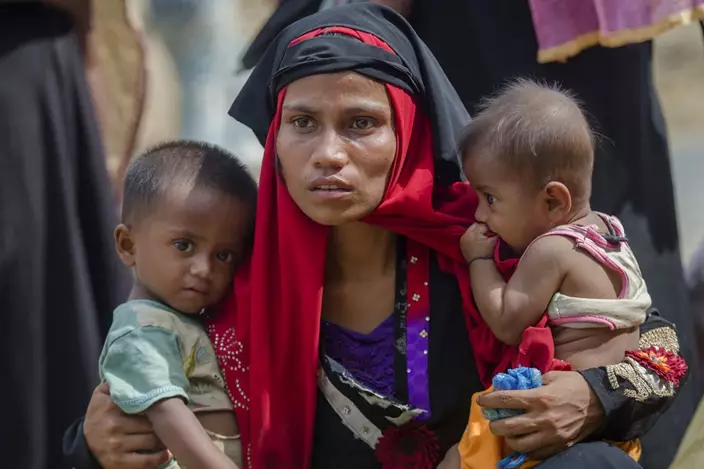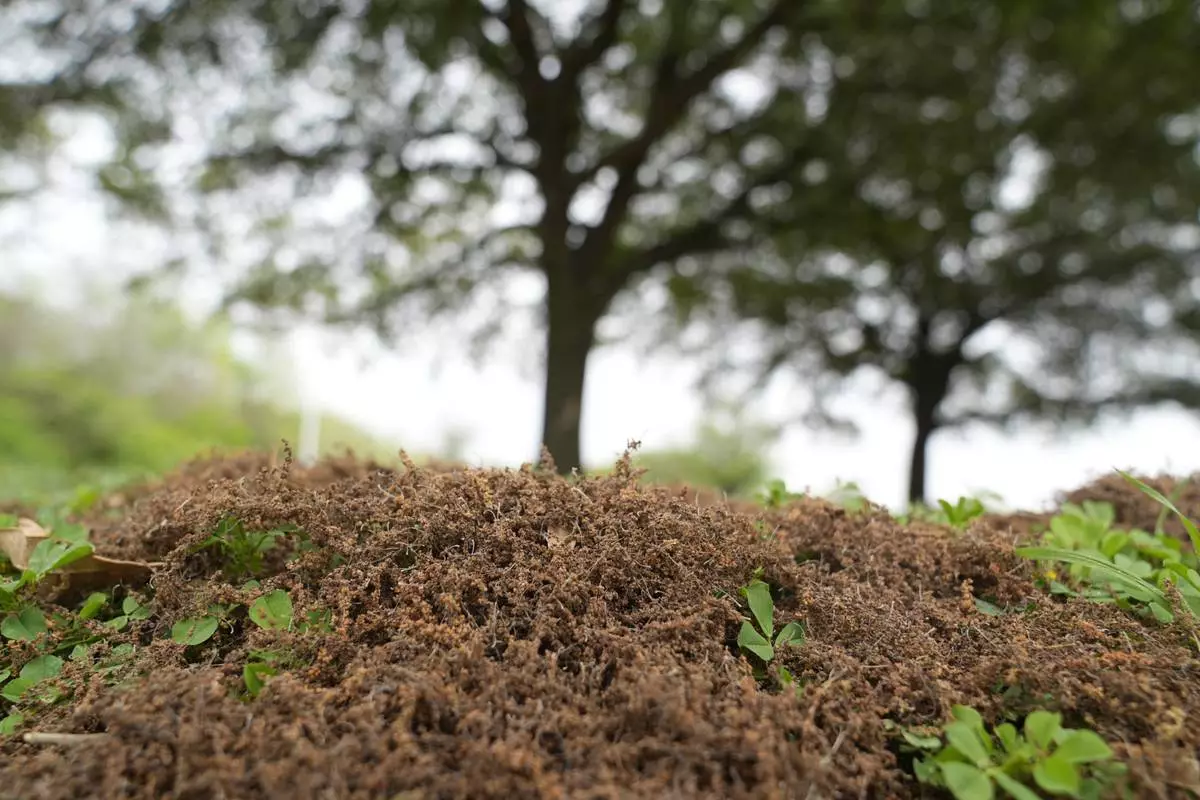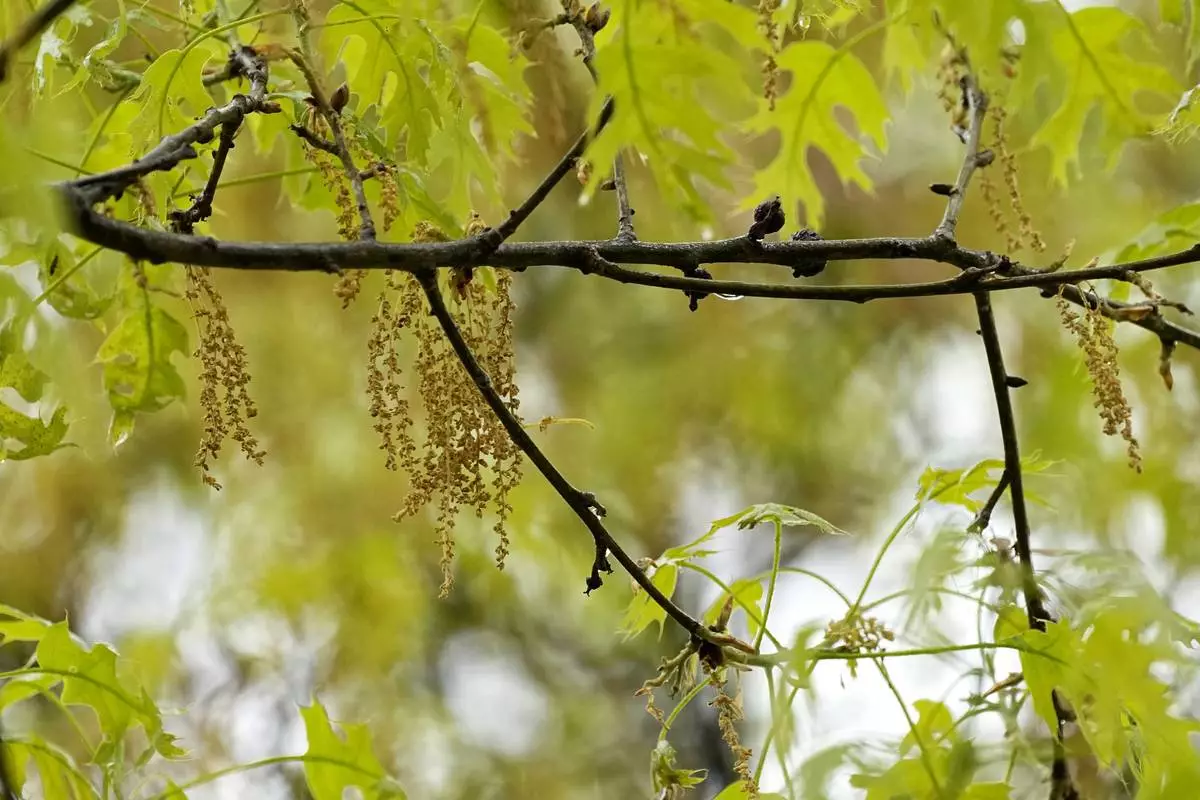The Myanmar military systematically prepared for attacks on Rohingya Muslims, confiscating knives and other sharp-edged tools, arming and training non-Muslim civilians and forcing Rohingya families to remove protective fences around their homes, the independent group Fortify Rights said Thursday.
The report by the Southeast Asian human rights group documented the preparations authorities made for a crackdown on the minority group living mostly in the country's western Rakhine state before a radical Rohingya group attacked Myanmar security force posts in late August 2017.
That attack was followed by what the United Nations and U.S. officials say was an ethnic cleansing campaign by the Myanmar government that led about 700,000 Rohingya to flee to Bangladesh amid harrowing violence.

FILE - In this Saturday, Oct. 21, 2017, file photo, Rohingya Muslim children, who crossed over from Myanmar into Bangladesh, wait pressed against each other to receive food distributed by a Turkish aid agency at the Thaingkhali refugee camp, Bangladesh. The Myanmar military has systematically prepared for attacks on Rohingya Muslims, confiscating knives and other sharp-edged tools, arming and training non-Muslim civilians and forcing Rohingya families to remove protective fencing from around their homes, the independent group Fortify Rights said Thursday. (AP Photo/Dar Yasin, File)
The report, based on extensive interviews, said the Myanmar army began confiscating knives and other items that could be used as weapons or for self-defense after a group of Rohingya attacked police outposts in October 2016. That prompted army-led attacks on dozens of villages that forced more than 94,000 people from their homes.
Authorities also seized chickens and other food from the Rohingya, it said.
The army also tore down or forced villagers to tear down fencing around their homes. It also trained and provided weapons to non-Rohingya living in Rakhine, suspended aid supplies and access by humanitarian groups to impoverished Rohingya communities, the report says.
"Taken together, these measures demonstrate a level of preparation not previously documented with respect to the Myanmar army-led 'clearance operations,'" it said.
Fortify Rights said the finding were based on 254 interviews of eyewitnesses and survivors, Bangladesh and Myanmar military and police officials, members of the radical Arakan Rohingya Salvation Army (ARSA), analysts, doctors and aid workers.
The report said the civilians who attacked Rohingya were not vigilantes but were trained by the army and given swords and guns.
"There are reasonable grounds to believe that the crimes perpetrated in all three townships of northern Rakhine state constitute genocide and crimes against humanity," it said, urging that those who perpetrated the violence be investigated.

FILE - In this Sunday, Oct. 22, 2017, file photo, Rohingya Muslim woman, Rukaya Begum, who crossed over from Myanmar into Bangladesh, holds her son Mahbubur Rehman, left and her daughter Rehana Bibi, after the government moved them to newly allocated refugee camp areas, near Kutupalong, Bangladesh. The Myanmar military has systematically prepared for attacks on Rohingya Muslims, confiscating knives and other sharp-edged tools, arming and training non-Muslim civilians and forcing Rohingya families to remove protective fencing from around their homes, the independent group Fortify Rights said Thursday. (AP Photo/Dar Yasin, File)
The report says top military and police officials should be held responsible.
It also holds ARSA members culpable for killing at least six people thought to be government informants and for interfering with fleeing civilians, some of whom were threatened with death if they failed to support the radicals.
The Myanmar military did not immediately comment on the report. It has denied committing atrocities and blames the violence on Rohingya insurgents.
The Rohingya face official and social discrimination in predominantly Buddhist Myanmar, which denies most of them citizenship and basic rights. They are considered immigrants from Bangladesh, even though many settled in Myanmar generations ago.
Dire conditions led more than 200,000 to flee the country between 2012 and 2015, before the latest violence flared.
Allergy season can bring misery to tens of millions of Americans each year.
Tree, grass, and other pollens can cause runny noses, itchy eyes, coughing and sneezing.
Where you live and what you're allergic to can make a big difference in how bad your allergies are, but there are many things you can do to feel better.
Here are some tips from experts to keep allergies at bay — maybe even enough to allow you to enjoy the outdoors.
There are three main types of pollen. Earlier in the spring, tree pollen is the main culprit. After that grasses pollinate, followed by weeds in the late summer and early fall.
Some of the most common tree pollens that cause allergies include birch, cedar, cottonwood, maple, elm, oak and walnut, according to the Asthma and Allergy Foundation of America. Grasses that cause symptoms include Bermuda, Johnson, rye and Kentucky bluegrass.
The best and first step to controlling allergies is avoiding exposure. That’s easier said than done when it's nice out.
Start with keeping your windows closed at home and in the car, avoiding going out when pollen counts are highest and changing clothes when you get home. The same masks that got us through the pandemic can protect you from allergies — though they won't help with eye symptoms.
Pollen trackers can help with planning. The American Academy of Allergy Asthma and Immunology tracks levels through a network of counting stations across the U.S. Counts are available at its website and via email.
You can't fight an enemy you don't know.
Since many Americans are allergic to several things at once, the first thing to figure out is what specifically you’re allergic to, said Dr. Nana Mireku, an allergist in the Dallas-Fort Worth area.
Over-the-counter nasal sprays can help relieve symptoms, but they take a while to kick in, so it’s best to start them in early in the season, said Dr. Rachna Shah, an allergist and director of the Loyola Medicine Allergy Count.
Antihistamines are another option. Shah said she’s seen some patients benefit from switching to a similar brand if one stops working, but said that there isn’t much broader data to back the recommendation.
For young children and people who have to take many different allergy medications, immunotherapies in the form of shots and oral drops can help desensitize the immune system to allergens, treating symptoms at their root.
The Asthma and Allergy Foundation of America issues an annual ranking of the most challenging cities to live in if you have allergies, based on over-the-counter medicine use, pollen counts and the number of available allergy specialists. This year, the top five were Wichita, Kansas; Virginia Beach, Virginia; Greenville, South Carolina; Dallas; and Oklahoma City.
If you've been thinking it started earlier and seems longer this year, you're on to something.
Shah usually starts looking at pollen counts in the Chicago area in April. But this year, she peeked at her data in mid-February, and tree pollen was already at a “moderate” level.
“This season has been so nuts,” she said. “Granted, it was a pretty mild winter, but I didn’t expect it to be so early.”
Shah said she believes this season will be longer than other years, assuming the weather remains warm.
Experts say climate change has led to longer and more intense allergy seasons.
The Associated Press Health and Science Department receives support from the Robert Wood Johnson Foundation. The AP is solely responsible for all content.

FILE - Tree pollen pods lay in a pile at a park in the Dallas suburb of Richardson, Texas, Thursday, March 21, 2024. The Asthma and Allergy Foundation of America issues an annual ranking of the most challenging cities to live in if you have allergies, based on over-the-counter medicine use, pollen counts and the number of available allergy specialists. In 2024, the top five were Wichita, Kansas; Virginia Beach, Virginia; Greenville, South Carolina; Dallas; and Oklahoma City. (AP Photo/LM Otero, File)

FILE - An oak tree with new leaf growth also shows pollen and a drop of water hanging among the branches at a park in Richardson, Texas, Thursday, March 21, 2024. There are three main types of pollen. Earlier in the spring, tree pollen is the main culprit. After that grasses pollinate, followed by weeds in the late summer and early fall. (AP Photo/Tony Gutierrez, File)













